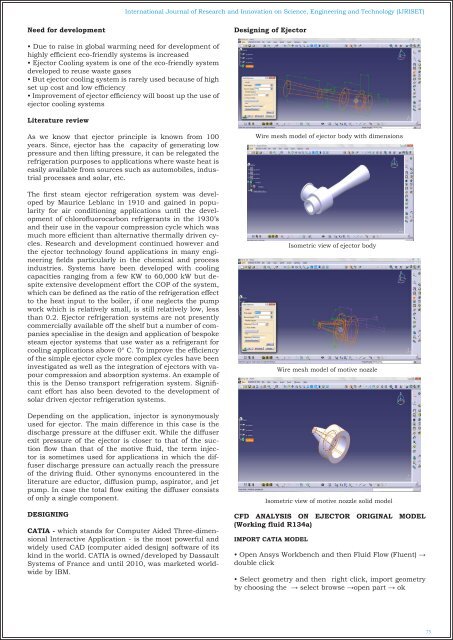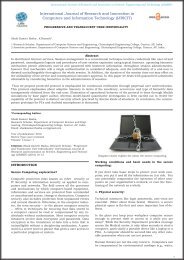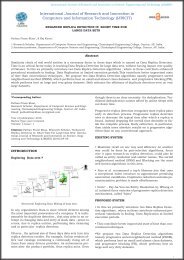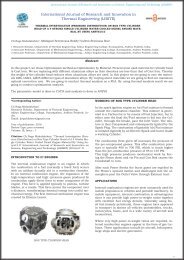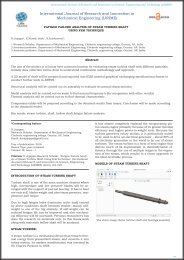IJRI-TE-03-010 CFD ANALYSIS ON EJECTOR COOLING SYSTEM WITH VARIABLE THROAT GEOMETRY
The vapor jet ejector cooling cycle driven by waste heat. It is a very auspicious approach of producing ‘free cooling’ by utilizing low-grade energy sources. The mechanism behind the ejector-based on waste heat cooling is very unique, when compared to absorption or adsorption cooling technologies. They are also aimed at producing heat driven cooling. This type of ejector cooling system is actually more closely related to vapor compression technology. In this paper simulations of a vapor-jet ejector operating with refregerent R134a as the working fluid by using CFD (computational fluid dynamics). The impact of varying geometry parameters on ejector performance will be considered. Different mixing section radii will be considered for the analysis. 3D modeling is done by using Catia V5 and analysis is done by Ansys fluent14.5.
The vapor jet ejector cooling cycle driven by waste heat. It is a very auspicious approach of producing ‘free cooling’ by
utilizing low-grade energy sources. The mechanism behind the ejector-based on waste heat cooling is very unique, when
compared to absorption or adsorption cooling technologies. They are also aimed at producing heat driven cooling. This
type of ejector cooling system is actually more closely related to vapor compression technology.
In this paper simulations of a vapor-jet ejector operating with refregerent R134a as the working fluid by using CFD
(computational fluid dynamics). The impact of varying geometry parameters on ejector performance will be considered.
Different mixing section radii will be considered for the analysis.
3D modeling is done by using Catia V5 and analysis is done by Ansys fluent14.5.
You also want an ePaper? Increase the reach of your titles
YUMPU automatically turns print PDFs into web optimized ePapers that Google loves.
International Journal of Research and Innovation on Science, Engineering and Technology (<strong>IJRI</strong>SET)<br />
Need for development<br />
Designing of Ejector<br />
• Due to raise in global warming need for development of<br />
highly efficient eco-friendly systems is increased<br />
• Ejector Cooling system is one of the eco-friendly system<br />
developed to reuse waste gases<br />
• But ejector cooling system is rarely used because of high<br />
set up cost and low efficiency<br />
• Improvement of ejector efficiency will boost up the use of<br />
ejector cooling systems<br />
Literature review<br />
As we know that ejector principle is known from 100<br />
years. Since, ejector has the capacity of generating low<br />
pressure and then lifting pressure, it can be relegated the<br />
refrigeration purposes to applications where waste heat is<br />
easily available from sources such as automobiles, industrial<br />
processes and solar, etc.<br />
The first steam ejector refrigeration system was developed<br />
by Maurice Leblanc in 1910 and gained in popularity<br />
for air conditioning applications until the development<br />
of chlorofluorocarbon refrigerants in the 1930’s<br />
and their use in the vapour compression cycle which was<br />
much more efficient than alternative thermally driven cycles.<br />
Research and development continued however and<br />
the ejector technology found applications in many engineering<br />
fields particularly in the chemical and process<br />
industries. Systems have been developed with cooling<br />
capacities ranging from a few KW to 60,000 kW but despite<br />
extensive development effort the COP of the system,<br />
which can be defined as the ratio of the refrigeration effect<br />
to the heat input to the boiler, if one neglects the pump<br />
work which is relatively small, is still relatively low, less<br />
than 0.2. Ejector refrigeration systems are not presently<br />
commercially available off the shelf but a number of companies<br />
specialise in the design and application of bespoke<br />
steam ejector systems that use water as a refrigerant for<br />
cooling applications above 0° C. To improve the efficiency<br />
of the simple ejector cycle more complex cycles have been<br />
investigated as well as the integration of ejectors with vapour<br />
compression and absorption systems. An example of<br />
this is the Denso transport refrigeration system. Significant<br />
effort has also been devoted to the development of<br />
solar driven ejector refrigeration systems.<br />
Depending on the application, injector is synonymously<br />
used for ejector. The main difference in this case is the<br />
discharge pressure at the diffuser exit. While the diffuser<br />
exit pressure of the ejector is closer to that of the suction<br />
flow than that of the motive fluid, the term injector<br />
is sometimes used for applications in which the diffuser<br />
discharge pressure can actually reach the pressure<br />
of the driving fluid. Other synonyms encountered in the<br />
literature are eductor, diffusion pump, aspirator, and jet<br />
pump. In case the total flow exiting the diffuser consists<br />
of only a single component.<br />
DESIGNING<br />
CATIA - which stands for Computer Aided Three-dimensional<br />
Interactive Application - is the most powerful and<br />
widely used CAD (computer aided design) software of its<br />
kind in the world. CATIA is owned/developed by Dassault<br />
Systems of France and until 2<strong>010</strong>, was marketed worldwide<br />
by IBM.<br />
Wire mesh model of ejector body with dimensions<br />
Isometric view of ejector body<br />
Wire mesh model of motive nozzle<br />
Isometric view of motive nozzle solid model<br />
<strong>CFD</strong> <strong>ANALYSIS</strong> <strong>ON</strong> <strong>EJECTOR</strong> ORIGINAL MODEL<br />
(Working fluid R134a)<br />
IMPORT CATIA MODEL<br />
• Open Ansys Workbench and then Fluid Flow (Fluent) →<br />
double click<br />
• Select geometry and then right click, import geometry<br />
by choosing the → select browse →open part → ok<br />
73


